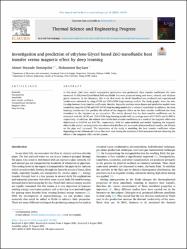| dc.contributor.author | Demirpolat, Ahmet Beyzade | |
| dc.date.accessioned | 2022-03-16T06:13:53Z | |
| dc.date.available | 2022-03-16T06:13:53Z | |
| dc.date.issued | 2021 | en_US |
| dc.identifier.citation | Demirpolat, A. B., & Baykara, M. (2021). Investigation and prediction of ethylene Glycol based ZnO nanofluidic heat transfer versus magnetic effect by deep learning. Thermal Science and Engineering Progress, 25, 101034. | en_US |
| dc.identifier.uri | https://doi.org/10.1016/j.tsep.2021.101034 | |
| dc.identifier.uri | https://hdl.handle.net/20.500.12899/647 | |
| dc.description.abstract | In this study, ZnO (zinc oxide) nanoparticle production was performed. Heat transfer coefficients (h) were measured for Ethylene Glycol Based ZnO nanofluids that were produced using pure water, ethanol, and ethylene glycol materials. In the literature, this is the first study in which Nanofluid was produced and experimental results were estimated by using LSTM and CNN-LSTM deep learning models. The study graphs’ show the relationship between heat transfer coefficients. Besides, Reynolds numbers were drawn and predictive models were created by using the LSTM and CNN-LSTM deep learning models for h values of nanofluids. In addition, the deep learning architecture that predicts the effects of the magnetic effect on the heat transfer coefficient has been introduced to the literature as an innovation. The results showed that the heat transfer coefficients can be estimated with the LSTM and CNN-LSTM deep learning model with an average error of 0.7342% and 0.2001% respectively. In addition, the relative error of the heat transfer coefficients as a result of the magnetic effect was determined as 0.02944 and 0.01701, respectively, with the same methods and model. Applying the magnetic effect to the system, an irregularity was observed in the flow and as a result of increased heat transfer, the friction on the pipe wall increased. The importance of the study is modeling the heat transfer coefficient values depending on the different pH values that were used during the synthesis of ZnO nanomaterial and observing the effects of the magnetic effect on the system. | en_US |
| dc.language.iso | en | en_US |
| dc.publisher | Elsevier Ltd | en_US |
| dc.relation.ispartof | Thermal Science and Engineering Progress | en_US |
| dc.rights | info:eu-repo/semantics/closedAccess | en_US |
| dc.subject | Computational intelligence | en_US |
| dc.subject | Deep learning | en_US |
| dc.subject | Heat transfer coefficient | en_US |
| dc.subject | Magnetic effect | en_US |
| dc.subject | Nanofluids | en_US |
| dc.subject | Nanoparticles | en_US |
| dc.title | Investigation and prediction of ethylene Glycol based ZnO nanofluidic heat transfer versus magnetic effect by deep learning | en_US |
| dc.type | Article | en_US |
| dc.authorid | 0000-0003-2533-3381 | en_US |
| dc.department | MTÖ Üniversitesi, Arapgir Meslek Yüksekokulu, Elektronik ve Otomasyon Bölümü | en_US |
| dc.institutionauthor | Demirpolat, Ahmet Beyzade | |
| dc.identifier.doi | 10.1016/j.tsep.2021.101034 | |
| dc.identifier.volume | 25 | en_US |
| dc.identifier.issue | 101034 | en_US |
| dc.identifier.startpage | 1 | en_US |
| dc.identifier.endpage | 12 | en_US |
| dc.relation.publicationcategory | Makale - Uluslararası Hakemli Dergi - Kurum Öğretim Elemanı | en_US |
| dc.identifier.scopus | 2-s2.0-85122827184 | en_US |
| dc.identifier.wos | WOS:000702533600009 | en_US |
| dc.identifier.wosquality | Q1 | en_US |
| dc.indekslendigikaynak | Web of Science | en_US |


















